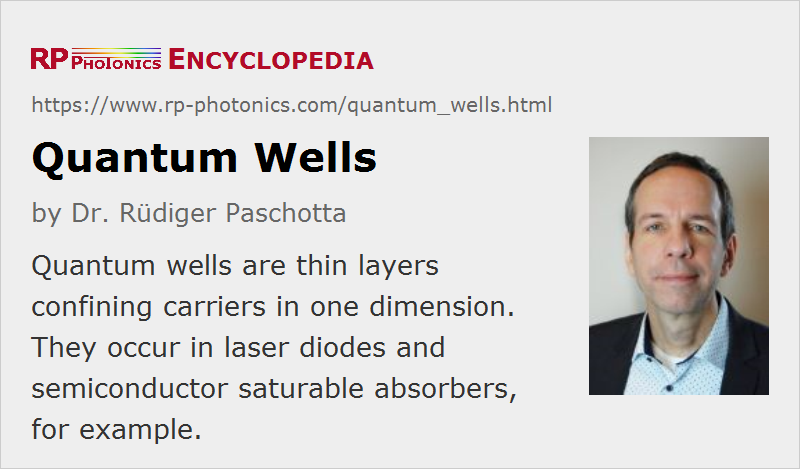Quantum Wells
Definition: thin layers confining carriers in one dimension
German: Quantenwälle
Categories:  photonic devices,
photonic devices,  quantum optics
quantum optics
Author: Dr. Rüdiger Paschotta
Cite the article using its DOI: https://doi.org/10.61835/w2q
Get citation code: Endnote (RIS) BibTex plain textHTML
A quantum well is a nanometer-thin layer which can confine (quasi-)particles (typically electrons or holes) in the dimension perpendicular to the layer surface, whereas the movement in the other dimensions is not restricted.
The confinement is a quantum effect. It has profound effects on the density of states for the confined particles. For a quantum well with a rectangular profile, the density of states is constant within certain energy intervals.
A quantum well is often realized with a thin layer of a semiconductor medium, embedded between other semiconductor layers of wider band gap (examples: GaAs quantum well embedded in AlGaAs, or InGaAs in GaAs). The thickness of such a quantum well is typically ≈ 5–20 nm. Such thin layers can be fabricated with molecular beam epitaxy (MBE) or metal–organic chemical vapor deposition (MOCVD). Both electrons and holes can be confined in semiconductor quantum wells. In optically pumped semiconductor lasers (→ vertical external-cavity surface-emitting lasers), most pump radiation may be absorbed in the layers around the quantum wells, and the generated carriers are captured by the quantum wells thereafter.
If a quantum well is subject to strain, as can be caused by a slight lattice mismatch (e.g., for InGaAs quantum wells in GaAs), the electronic states are further modified, which can even be useful in laser diodes.
Semiconductor quantum wells are often used in the active regions of laser diodes, where they are sandwiched between two wider layers with a higher band gap energy. These cladding layers function as a waveguide, while electrons and holes are efficiently captured by the quantum well (separate confinement), if the difference in bandgap energies is sufficiently large. Quantum wells are also used as absorbers in semiconductor saturable absorber mirrors (SESAMs), and in electroabsorption modulators.
If a large amount of optical gain or absorption is required, multiple quantum wells (MQWs) can be used, with a spacing typically chosen large enough to avoid overlap of the corresponding wave functions.
More to Learn
Encyclopedia articles:
Bibliography
| [1] | T. Makino, “Analytical formulas for the optical gain of quantum wells”, IEEE J. Quantum Electron. 32, 493 (1995); https://doi.org/10.1109/3.485401 |
| [2] | P. S. Zory (ed.), Quantum Well Lasers – Principles and Applications, Academic Press, New York (1993) |
Questions and Comments from Users
Here you can submit questions and comments. As far as they get accepted by the author, they will appear above this paragraph together with the author’s answer. The author will decide on acceptance based on certain criteria. Essentially, the issue must be of sufficiently broad interest.
Please do not enter personal data here; we would otherwise delete it soon. (See also our privacy declaration.) If you wish to receive personal feedback or consultancy from the author, please contact him, e.g. via e-mail.
By submitting the information, you give your consent to the potential publication of your inputs on our website according to our rules. (If you later retract your consent, we will delete those inputs.) As your inputs are first reviewed by the author, they may be published with some delay.


Connect and share this with your network:
Follow our specific LinkedIn pages for more insights and updates: